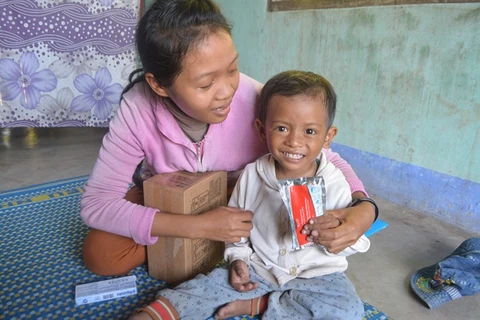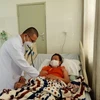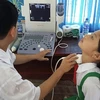Hanoi (VNA) - Vietnamese people are zinc deficient at an alarming rate, especially pregnant women and young children.
The information was announced at a recent symposium to welcome Vietnam Micronutrient Day (June 1-2).
A survey conducted in 2015 showed that nearly 70 percent of children under five suffer from zinc deficiency. Children from mountainous areas are most affected, at 80.8 percent. The figures are 71.6 percent for children in rural areas and 49.7 percent for children in urban areas.
Zinc deficiency is also common among women. About 64 percent of women of reproductive age are zinc deficient while the rate is 80 percent for pregnant women.
Zinc is an essential mineral which affects many organ systems, including the immune, skeletal, reproductive, and central nervous systems.
“Zinc is involved in the activity of more than 200 enzymes in the body, which affects the height and intellectual development of a child. Zinc deficiency during pregnancy increases the risk of complications,” said Dr Tran Khanh Van, deputy head of Micronutrient Department of the National Institute of Nutrition (NIN).
Associate Professor Nguyen Thi Lam, NIN vice director, added that zinc deficiency may also result in malnutrition, being underweight, loss of appetite, sleep disorder, and disturbed sleep.
The body does not produce zinc so people have to absorb zinc from food.
According to a NIN report, Vietnamese people’s daily meals generally provide enough energy and protein but not enough vitamins and minerals.
This is the main reason for zinc deficiency.
An average infant should consume 2-3 milligrams of zinc daily, while a 4-8kg child should consume 5mg. Adult men should aim to consume about 11 milligrams of zinc daily, while adult women need about 8 milligrams. Pregnant women and nursing women require 11 to 12 milligrams and 12 to 13 milligrams per day, respectively.
According to experts, zinc deficiency can be treated by increasing intake of zinc through the diet or through zinc supplements.
The mineral is present in many foods and is especially rich in seafood like oysters, shrimp, or crab; meat like pork, chicken, or egg yolks, peanuts and pumpkin seeds.
Zinc is, however, not the only mineral that Vietnamese people’s meals lack.
According to NIN, the diets of Vietnamese people have led to the deficiency of various important vitamins and minerals, such as vitamin A, iodine, iron, calcium, and vitamin D.
Vitamins and minerals are needed in tiny quantities, but their absence can be devastating.
“Micronutrient deficiency is considered a “hidden-hunger” with far-reaching consequences, such as physical and intellectual growth retardation, or a decrease in reproductive and working capability,” Dr Van said.
Dr Van said people of all ages are prone to micronutrient deficiency, but those at high risk are young children and pregnant women.
About 13 percent of children under five suffer from preclinical vitamin A deficiency. According to experts, their meals only provide about 65 percent of the amount needed.
Meanwhile, 34.8 percent of nursing women have low rate of vitamin A in their milk for the same reason.
Anemia appears in 27.8 percent of children under five and 32.8 percent of pregnant women.
Doctors recommend that people increase their intake of micronutrients by having a diverse diet and eating micronutrient-rich food.
“This is a simple, yet effective and substantial method to solve the micronutrient deficiency situation and increase people’s health and living quality,” said Associate Professor Truong Tuyet Mai, NIN vice director, adding that communication and education should be used to raise the awareness of people on micronutrient-rich foods.-VNA
The information was announced at a recent symposium to welcome Vietnam Micronutrient Day (June 1-2).
A survey conducted in 2015 showed that nearly 70 percent of children under five suffer from zinc deficiency. Children from mountainous areas are most affected, at 80.8 percent. The figures are 71.6 percent for children in rural areas and 49.7 percent for children in urban areas.
Zinc deficiency is also common among women. About 64 percent of women of reproductive age are zinc deficient while the rate is 80 percent for pregnant women.
Zinc is an essential mineral which affects many organ systems, including the immune, skeletal, reproductive, and central nervous systems.
“Zinc is involved in the activity of more than 200 enzymes in the body, which affects the height and intellectual development of a child. Zinc deficiency during pregnancy increases the risk of complications,” said Dr Tran Khanh Van, deputy head of Micronutrient Department of the National Institute of Nutrition (NIN).
Associate Professor Nguyen Thi Lam, NIN vice director, added that zinc deficiency may also result in malnutrition, being underweight, loss of appetite, sleep disorder, and disturbed sleep.
The body does not produce zinc so people have to absorb zinc from food.
According to a NIN report, Vietnamese people’s daily meals generally provide enough energy and protein but not enough vitamins and minerals.
This is the main reason for zinc deficiency.
An average infant should consume 2-3 milligrams of zinc daily, while a 4-8kg child should consume 5mg. Adult men should aim to consume about 11 milligrams of zinc daily, while adult women need about 8 milligrams. Pregnant women and nursing women require 11 to 12 milligrams and 12 to 13 milligrams per day, respectively.
According to experts, zinc deficiency can be treated by increasing intake of zinc through the diet or through zinc supplements.
The mineral is present in many foods and is especially rich in seafood like oysters, shrimp, or crab; meat like pork, chicken, or egg yolks, peanuts and pumpkin seeds.
Zinc is, however, not the only mineral that Vietnamese people’s meals lack.
According to NIN, the diets of Vietnamese people have led to the deficiency of various important vitamins and minerals, such as vitamin A, iodine, iron, calcium, and vitamin D.
Vitamins and minerals are needed in tiny quantities, but their absence can be devastating.
“Micronutrient deficiency is considered a “hidden-hunger” with far-reaching consequences, such as physical and intellectual growth retardation, or a decrease in reproductive and working capability,” Dr Van said.
Dr Van said people of all ages are prone to micronutrient deficiency, but those at high risk are young children and pregnant women.
About 13 percent of children under five suffer from preclinical vitamin A deficiency. According to experts, their meals only provide about 65 percent of the amount needed.
Meanwhile, 34.8 percent of nursing women have low rate of vitamin A in their milk for the same reason.
Anemia appears in 27.8 percent of children under five and 32.8 percent of pregnant women.
Doctors recommend that people increase their intake of micronutrients by having a diverse diet and eating micronutrient-rich food.
“This is a simple, yet effective and substantial method to solve the micronutrient deficiency situation and increase people’s health and living quality,” said Associate Professor Truong Tuyet Mai, NIN vice director, adding that communication and education should be used to raise the awareness of people on micronutrient-rich foods.-VNA
VNA
























